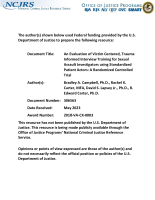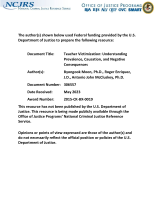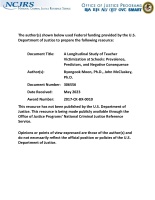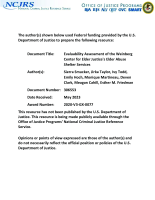Victims of crime
An Evaluation of Victim Centered, Trauma Informed Interview Training for Sexual Assault Investigators using Standardized Patient Actors: A Randomized Controlled Trial
Teacher Victimization: Understanding Prevalence, Causation, and Negative Consequences
A Longitudinal Study of Teacher Victimization at Schools: Prevalence, Predictors, and Negative Consequence
Evaluability Assessment of the Weinberg Center for Elder Justice's Elder Abuse Shelter Services
Considering domestic violence victims: Exploring victim-related factors in prosecutor case summaries
Enhancing Response to Victims: A Formative Evaluation of OVC's Law Enforcement-Based Victim Services (LEV) Program: Summary Results from Phase One of the Formative Evaluation
It's a Marathon Not a Race: Exiting the Commercial Sex Trade
Measuring the Impact of Victim Services
National Institute of Justice Annual Report 2020
Sexual Assault in Alaska
NIJ FY23 Research and Evaluation of Services for Victims of Crime
Helping Crime Victim Legal Clinics Help Their Clients by Defining and Measuring for Successful Outcomes
Gender-Based Violence and the Latinx Community
See the YouTube Terms of Service and Google Privacy Policy
Economic Justice for Survivors of Intimate Partner Violence
See the YouTube Terms of Service and Google Privacy Policy
Defining and Studying Elder Abuse Polyvictimization
Defining and Studying Elder Abuse Polyvictimization
NIJ Social Science Analyst Yunsoo Park shares her knowledge about elder abuse, a widespread issue in the U.S. and around the world, particularly polyvictimization — the experience of a range of different types of abuse and maltreatment. As much as 11% of community-residing older adults experienced some form of abuse or mistreatment in the past year. Yunsoo discusses risk factors, difficulties in defining and studying elder abuse polyvictimization, and strategies for intervention and prevention. Stacy Lee Reynolds, a Communications Assistant with NIJ, hosts.










